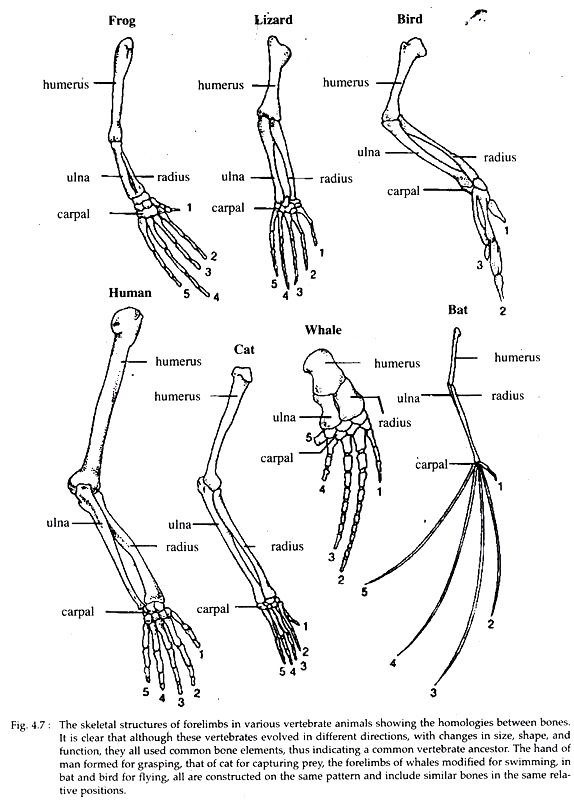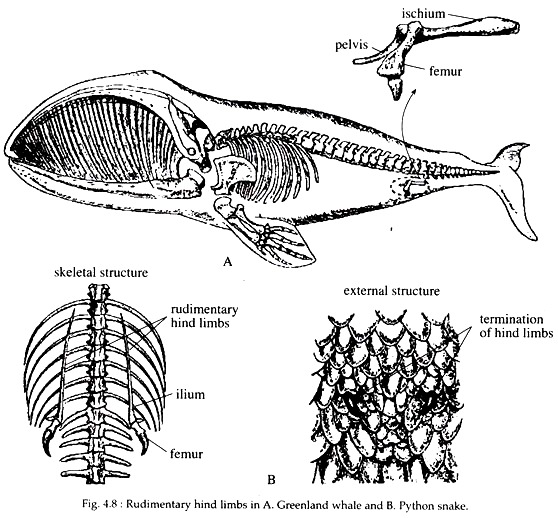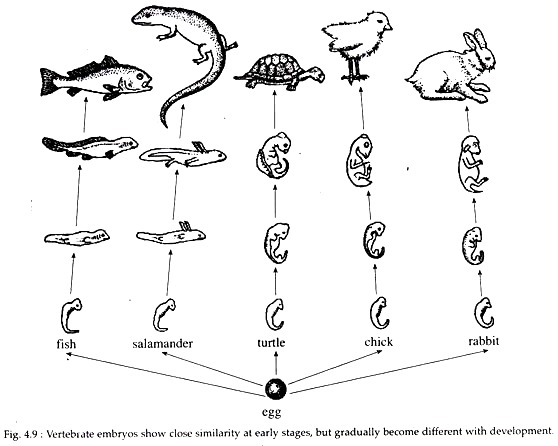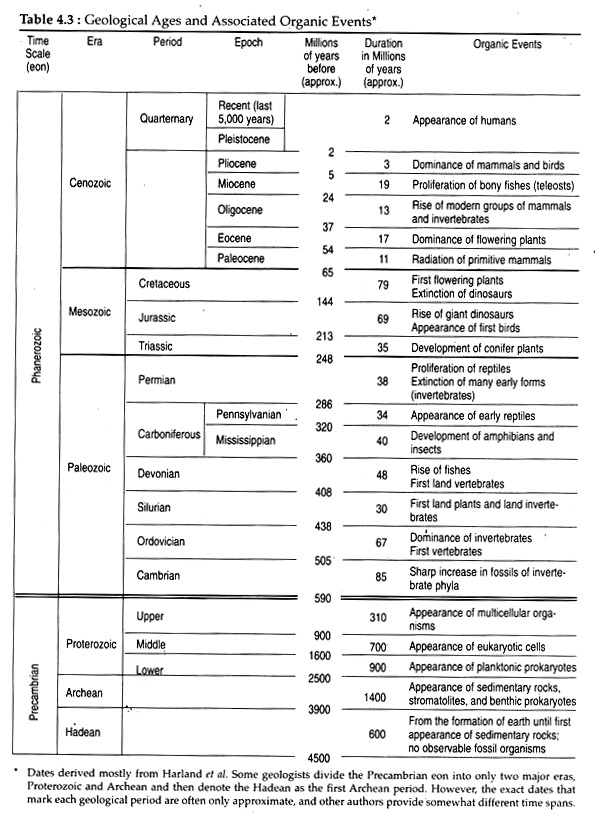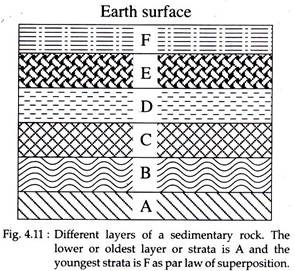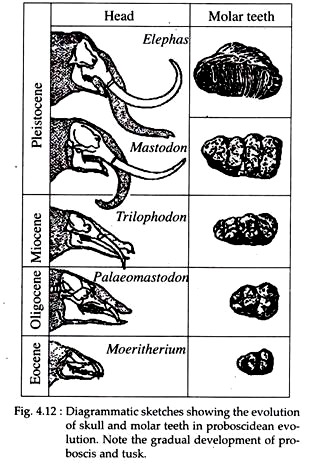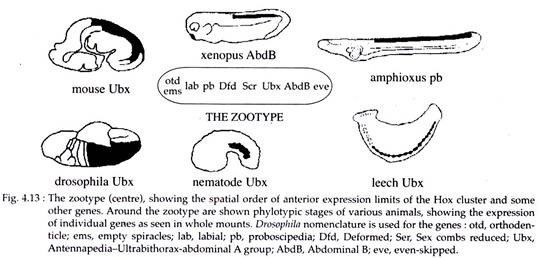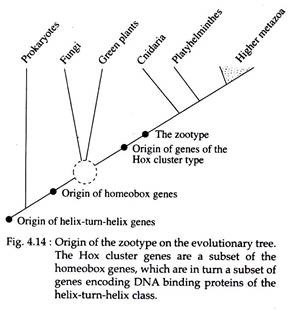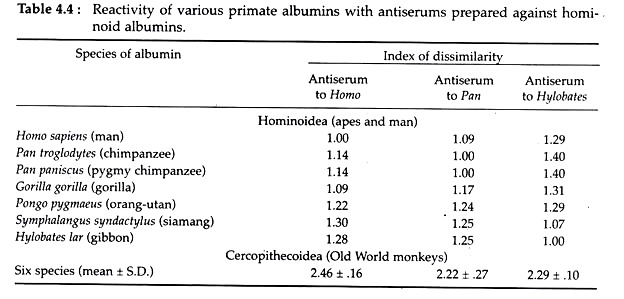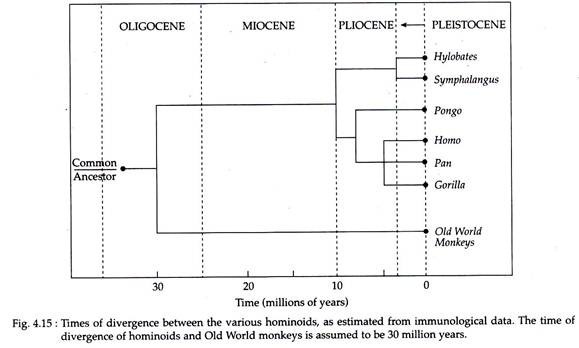The following points highlight the top five evidences of organic evolution. The evidences are: 1. Morphological Evidences 2. Embryological Evidences 3. Geographical Evidences 4. Geological Evidences 5. Comparative Physiology and Biochemical Evidences.
Organic Evolution: Evidence # 1.
Morphological Evidences:
The evidences from morphological deviations for a particular structure in different groups of organisms, provide a good picture of evolution of that structure. If any structure of an organism is considered to be a representative of the total development then from their morphological studies it can be said which structure was primitive.
Here, we are considering some of the organs of animals which can explain their evolution in different group of animals.
ADVERTISEMENTS:
A. Homologous Organs:
The organs which developed or originated from a common structure but may function differently or attain different shapes for different functions in different groups are called homologous organs.
Example:
Fore limbs of different vertebrates (Fig. 4.7)
Explanation:
Consider the skeletal structures of fore limb of man, horse, bat, whale, bird, lizard and frog. It is clear from their skeletal structures that all possess same limb bones but are suitably modified for exploring different habitats. The limb bones are humerurs, radius ulna, carpals, metacarpals etc.
Conclusion:
Therefore, it can be said that all the above mentioned animals exhibit divergent evolution and originated from a common ancestor.
ADVERTISEMENTS:
B. Analogous Organs:
The organs which perform same function in different groups of animals but do not show a common underlying plan of structure are called analogous organs.
Example:
(i) The wings of bats and wings of insects,
(ii) Eyes of octopus and that of mammals.
Explanation:
(i) The function of wings are same – it helps in flying in both bats and insects. But they do not possess common internal plan and these organs were not evolutionarily developed from the same organ.
(ii) Eyes help in vision in both the organisms i.e., in octopus and mammals, but they had different evolutionary origins since these two structures arose embryonically from two different tissues.
Conclusion:
ADVERTISEMENTS:
The development of different parts of different organisms in a similar direction is called convergent evolution. This indicates that nature selects similar type of organs for a particular habitat, although they do not possess identical anatomical structures.
C. Vestigial Organs:
Organs or structures of organism which appear to be small and functionless at present, but can be shown to be homologous with ancestral organs and structures that were larger and functional at one time are called vestigial organs.
Example:
(i) The rudimentary bones of former hind limbs in the whale and snakes (Fig. 4.8).
(ii) Muscles of external ears, reduced tail bones, the appendix of the cecum, rudimentary body hair, etc. are the vestigial organs of man.
Explanation:
All the present day vestigial characters were very much functional in the respective organism’s ancestors. But the organs became rudimentary in their predecessors.
Conclusion:
Vestigial organs develop due to adaptations to a new environment where some previously evolved structures were no longer necessary. Moreover, the structures which were no longer necessary might well interfere with function of new adaptations. So during a time period the obsolete structures tended to diminish.
Organic Evolution: Evidence # 2.
Embryological Evidences:
Study of embryological stages of different groups of animals show clear evidences of evolution. This was first noticed by von Baer. He observed the remarkable similarity between the embryos of vertebrates which are quite different on becoming adults. This observation together with other examples led, Earnst Haeckel to propose the concept of ‘Biogenetic Law’. This concept is also known as ‘Recapitulation theory’.
Biogenetic Law of Haeckel:
Ontogeny (embryonic development of the individual) is a concise and compressed recapitulation of phylogeny (the ancestral sequence).
An individual repeats during the rapid and short course of its embryonic development, the most important of the form- changes which its ancestors traversed during the long and slow course of their palaeontological evolution, in accordance with the laws of heredity and adaptations.
Support of this Theory:
Haeckel and many embryologists put forward many evidences in support of recapitulation theory. These are:
(i) Existence of close similarity between embryos of different vertebrates in early stages of development (Fig. 4.9).
(ii) The heart in vertebrate series is built on common basic plan, it consists of two portions — receiving parts and forwarding parts. The receiving parts comprise of auricle and sinus venosus while the forwarding parts consist of ventricle and conus arteriosus.
(iii) In embryonic stages of all vertebrates, the arterial arches are alike. In all vertebrate embryos, there are six pairs of arterial arches.
(iv) Presence of gill-slits in all vertebrate embryos.
(v) In vertebrates, nervous system originates by in-folding of dorsal ectoderm.
(vi) Nearly all the crustaceans pass through nauplius larva stage.
(vii) Tadpole larva of frog resembles fish.
(viii) Mollusca and Annelida pass through trochophore larva stage.
(ix) Covering of long hair in human babies (Lanugo). (10) Antlers of some living deer resemble those of fossil forms.
(x) Often tail is present in human being.
(xi) In the ontogenetic development of kidney in higher vertebrates there is a succession of Pro-, Meso- and Metanephros types.
(xii) Almost all the coelenterates have planula larva.
(xiii) The vertebrae in different vertebrates develop from the same source and in a similar way.
Present Status of Biogenetic Law or Recapitulation Theory:
Since the proposition of the law, several scientists tried to explain it in different ways. Some argued in favour of the proposal and some against it. However, Haeckel’s theory initiates a new branch of embryological studies — the ‘experimental embryology’.
Now-a-days his original ideas are not taken as such but have been modified. As the embryonic development is an epigenetic phenomenon, superficial similarities between the embryos are likely to be present.
Haeckel’s recapitulation theory can presently be interpreted as ‘the individual’s developmental stages (ontogeny) may at best repeat the ontogenetic stages of the racial forms (phytogeny) and not the phylogenetic stages as such’.
Organic Evolution: Evidence # 3.
Geographical Evidences:
The geographical evidences of evolution are found from the studies of the distribution of organisms (both plants and animals) through the different geographical areas of earth in time and space. These studies are under the subject ‘Bio-Geography’. The distribution of organism is dynamic and the factors restricting the distribution are called ‘barriers’.
Barriers:
It is the instinct of every organism to spread over the surface of earth. But earth/nature never allows that. Therefore, we can see, there are several barriers to restrict the movement of the organism. The barriers can be categorized as follows.
(i) Physical Barriers:
Nature’s physical obstacles to a particular organism is considered under physical barriers, viz., extensive mountain range, large bodies of water ‘s, land masses, etc. It prevents organism to spread over.
(ii) Climatic Barriers:
Extreme temperatures, heavy moisture, etc., become barricade for spreading in some organisms.
(iii) Biological Barriers:
Food, vegetation, competitors, parasites, predators, etc., are some of the important biological barriers to restrict the movement of organisms. The barriers, we have studied so far, are prevalent in present day earth.
The barriers, we see today might not have been present in the past. So, group of organism spreads all over the area and when barrier appeared between them, it changed the atmospheric condition on both sides, which ultimately gave rise to new kind of organisms (Fig. 4.10).
Therefore, it can be said that newly formed organisms were evolved from the same ancestor. These type of organisms show a trend of discontinuous distribution at present — which is studied under ‘Bio- geographical realm’.
Bio-geographical Realms:
On the basis of the presence and absence of several organisms the earth can be divided into some regions. These regions are called as ‘realms’. Several scientists proposed several scheme of realms. Organic
Evolution: Evidence # 4.
Geological Evidences:
The evidences, which come from the study of rocks, soils and the fossils contained in them, are considered as geological evidences. Sometimes it is also called as palaeontological evidences. But palaeontology only deals with fossils. Biologists and geologists correlated the rocks, strata of soil, fossils contained in them and time periods of the past, to draw a scale which is known as ‘Geological time scale’ (Table 4.3).
The geologists came to realise that the relative position of different rocks could be used to determine their relative ages.
Geologist ‘Steno’ proposed a law which is as follows:
Law of Superposition:
According to this law, ‘if a series of sedimentary rocks have not been overturned, the oldest layers of strata will be at the bottom of the series and the youngest stratum will be at the top’ (Fig. 4.11).
After the proposition of ‘Law of super-position’, W. Smith, a palaeontologist discovered that different strata of the earth may be identified by the unique kinds of fossils found within them. Later, Cuvier and others showed that the relative ages of the fossils correspond closely to the relative ages of the strata in which they were discovered.
Therefore, it can be said that the fossils available from the uppermost strata are more modern organisms than fossils from the lower strata.
Example:
The evolution of elephant from Eocene to Pleistocene period (Fig. 4.12).
Explanation:
Mderitherium is the first proboscidean found in Eocene period. Then appeared Palaeomastodon, Trilophodon, Mastodon and Elephas in oligocene, miocene and pleistocene, respectively. All these forms are completely recorded by series of fossils.
Organic Evolution: Evidence # 5.
Comparative Physiology and Biochemical Evidences:
During evolution, the change of structure is always accompanied by physiological and bio-chemical changes. All living organisms are basically built on one substance — the protoplasm in the cell. Therefore, fundamental properties of living things remain rather constant.
The variations of function of cells are more due to adaptation. It is well known that the activity of a cell or organism is basically controlled by the chromosome, which is characteristically composed of some basic substances — the nucleic acids like DNA or RNA. All these facts clearly point that all the living organisms originated from the same ancestor.
Example:
Activity of enzymes and hormones.
Explanation:
The chemical composition and physiological functions of the enzymes and hormones are closely identical among organisms. A protein splitting enzyme, trypsin, is present from protozoans to mammals. Insulin, extracted from other mammals is used in diabetic human beings. The thyroid hormone is similar in all vertebrates.
Conclusion:
All these observations prove one aspect of evolution, i.e., all organisms have common origin. There are some biochemical substances found in different animals and plants which clearly show the route of origin. They are as follows.
(i) Origin of Zootype:
What is Zootype? An animal is an organism that displays a particular spatial pattern of gene expression, which is called zootype (Fig. 4.13). The zootype is expressed most clearly at a particular stage of embryonic development, the phylotypic stage. The phylotypic stage is the stage of development at which all major body parts are represented in their final positions as undifferentiated cell condensations i.e., fate map.
Explanation:
The origin of zootype in the evolutionary tree shows that there was once a primordial multicellular ancestor of all existing animals (Fig. 4.13) and this ancestor was the first organism to possess zootype.
Although the zootype is not visible, but on casual inspection, the presence of the genes can be established by using polymerase chain reaction (Fig. 4.14). The area of the phylotypic stage where gene expression is visible could be compared for deciding the affinities of various organisms.
(ii) Immunological Time Scale for Hominid Evolution:
It is generally agreed that the African apes are our closest living relatives. But there are no fossil records or other evidences. So, controversy remained for over 100 years. Now the question is how it can be solved? One solution to this question lies in the measurement of the degree of genetic relationship which exists between man and his closest living relatives.
As it is clear that the structure of proteins closely reflects that of genes, it is to be expected that quantitative comparative studies of protein structure should aid in providing this measure of genetic relationship.
Serum albumin molecule is one of the ancestral molecules that is present in the ancestor of chimpanzee and man. As proteins evolved over time, therefore, from the time that the human and chimpanzee lineages separated, their albumins have had the opportunity of evolving independently.
Until today they are recognizable as different, but homologously related molecules. This property is used in preparing an immunological time scale.
Antigen-antibody reactions were performed with the serum samples from the different related hominids. The degrees of cross-reactions were expressed quantitatively as the index of dissimilarity or immunological distance (ID) (Table 4.4).
It is known that the amino acid sequence of a protein evolve at a steady rate. Therefore, the relationship between ID and time of divergence should be of the same form as the relationship between ID and structural differences (number of amino acid replacement).
It can be calculated from the following formula — log ID = kT, where k is the constant. It shows that log ID is approximately proportional to the time of divergence. Using this formula a scale is prepared (Fig. 4.15) from the data of Table 4.4 for hominid evolution.
Example:
Although the primate fossil record is fragmentary, it does, in combination with the available immunological evidence, provide sufficient evidence to suggest that lineages of living hominids and old world monkeys split about 30 million years ago.
Therefore, from table 4.4, the ID of 2.3 between hominids and old world monkeys corresponds to a T value of about 30 in the above equation i.e. log 2.3 = k x 30, So, k = 0.012, using this k value other data’s are compared and the scale is prepared.
